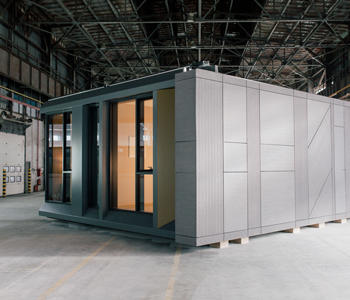UPDATE, Monday, August 5, 2019: The next chapter in the arms race to build the tallest hotel using modular construction is under way, though doubts remain on the method’s merit.
With about $65 million in construction financing secured from Avana Capital, the Chun family is finally developing the plot they’ve held since 1993 at 842 Sixth Avenue into a 168-key AC by Marriott using nontraditional building methods. The AC property is the second hotel developed by the Chun family, led by Robert Chun, in NoMad.

A module of AC by Marriott
Building tall using modular construction, which means a large portion of the project is built off-site in modules that are then transported and assembled, is relatively new (modular low-rise using wood has been common for decades). For the NoMad hotel, its modules are being manufactured in a factory in Poland by the general contractor on the project, Skystone Group, and subcontractor, DMD Modular.
At 360 feet tall, the Chuns’ new hotel will beat the current title holder, the recently-opened CitizenM on the Lower East Side, by 114 feet.
In a statement, Marriott International’s chief development officer Eric Jacobs called the hotel “as a game-changing symbol,” but the merit of the claim to fame is dubious to some even within the modular industry. Roger Krulak — a former Forest City Ratner executive who now runs one of the few modular construction firms in the city — shrugged off the achievement back when CitizenM opened saying, “it’s like if it were the tallest modular animal hospital in the world.”
The more lauded achievement would be to see the NoMad hotel built using modular construction techniques that added up to indisputable time and cost savings compared to traditional construction. That’s a feat that’s yet to be done in New York City where unforeseen challenges have occurred in many of the highest profile modular projects.
Richard Born’s BD Hotels built the city’s first modular hotel in Williamsburg, the Pod BK, said he “would not do a 25-story modular building,” due to unforeseen challenges. CitizenM’s modular Bowery hotel opened more than year later than scheduled and the construction process was restarted due to delays.
Jacobs pushed back against the widely-held idea that modular’s track record is unproven, noting that the hotel giant has completed 31 modular hotels in the U.S. and, based on those projects, the construction period takes about half the time compared to traditionally-built properties.
Marriott is viewed in the industry as a trailblazer for modular construction, but it was the Chuns’ architect Danny Forster who proposed modular for the NoMad property because the design the Chuns settled on consisted of a tall, symmetrical tower with repeating floor plans.
Unlike the hotel giant, the New York City-based architect acknowledged that “there isn’t this track record of high-fives where everyone’s really comfortable,” and compared the NoMad project to vetting a case headed to the Supreme Court.
“I like to think this is the right plaintiff to demonstrate that this can work,” he said. “We’re trying to build a building where people can say ‘It is cheaper. It is faster. It is better,’ as opposed to what you have now which is ‘Yeah, it’s pretty cool, but I’ve heard this.'”
Marriott first started promoting modular in 2015 within the hospitality industry, where the construction technique has long been associated with low quality construction. In 2017, Marriott built its largest modular hotel to date in Los Angeles and Avana provided the financing on that project. It was the lender’s first modular project and Marriott brought Avana to the Chuns’ NoMad deal.
For lenders, modular construction is filled with risks, particularly with the modules being manufactured overseas. To mitigate the risk, Avana visited the factory and even has access to a live camera feed set up in the Karkow factory in order to monitor the project. Avana’s managing director Sanat Patel joked that he watches live every morning: “That’s part of my morning routine basically.” He said they do weekly inspections.
Another major difference between financing a traditionally-built project versus modular is when capital is being deployed. “You’re funding a lot more at the front end of the project,” said Patel.
Forster said manufacturing modules can account for up to 35 percent of a project budget and, unlike in traditional construction where building only begins once demolition is complete, modules have to be built ahead of time. His firm is currently working on three other modular projects, including a second high-rise hotel for Marriott in Brooklyn and a five-star Wyndham hotel on the island of Nevis.
“A developer is typically responsible for nothing more than soft costs until you dig a hole,” Forster explained. “We’re building a shit load of the building well before we’ve dug a hole.”
Patel said Avana took the additional measures to work out the riskier aspects of financing a modular project because the firm believes this kind of construction is going to happen more.
New York City’s government agencies also have a horse in the race, albeit indirectly. Before leaving the office, former deputy mayor Alicia Glen described the administration as “particularly interested in modular’s potential for delivering affordable housing faster and more cost effectively.” The mayor’s office has something called the “Mod Squad” where city officials show up at all the industry conferences to talk about modular, but sources within the administration recognized modular construction’s ability to deliver is still in question.
“It has a lot of hype and promise, but the reality has been, you know, complicated,” said one source familiar with the city’s work with modular. “There aren’t that many precedents to point to where it’s really saved the time. Or the cost.”
Clarification: The subcontractor involved in the project was added into the third paragraph.
